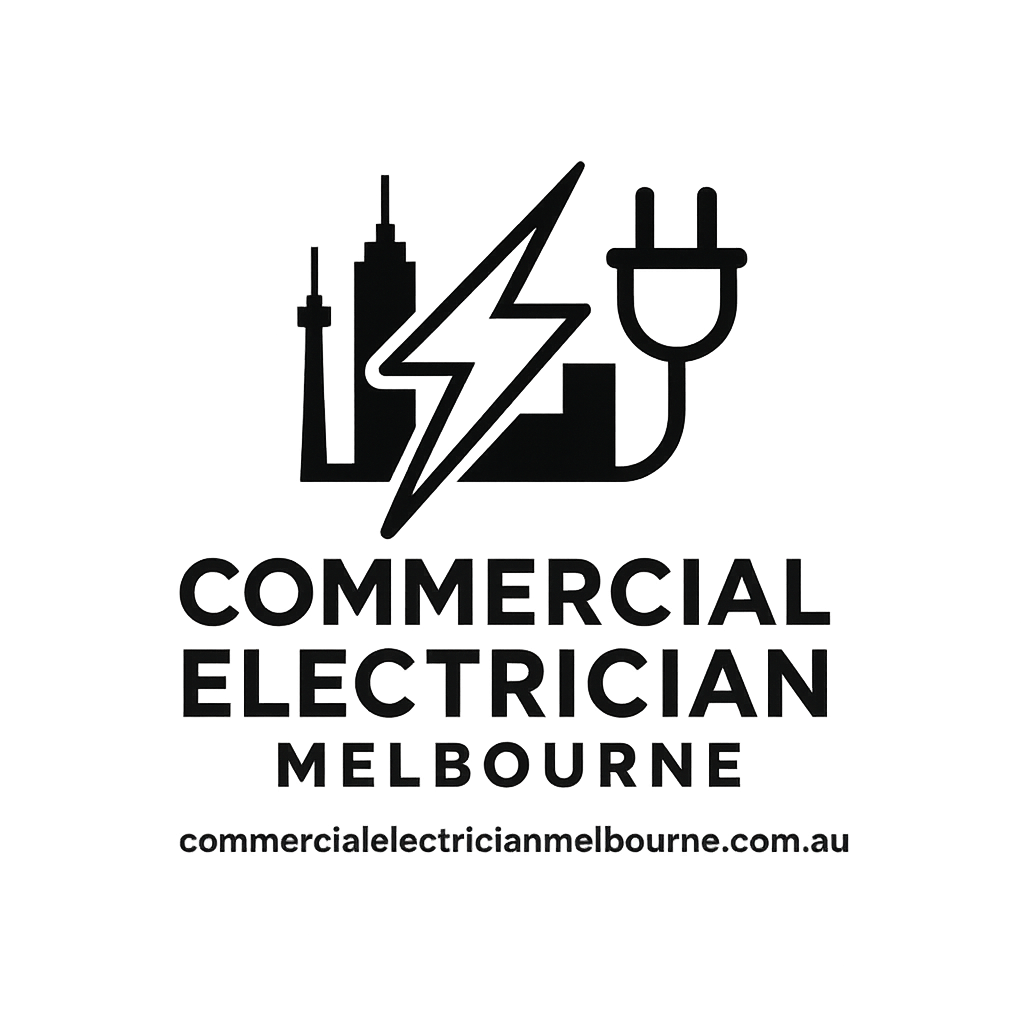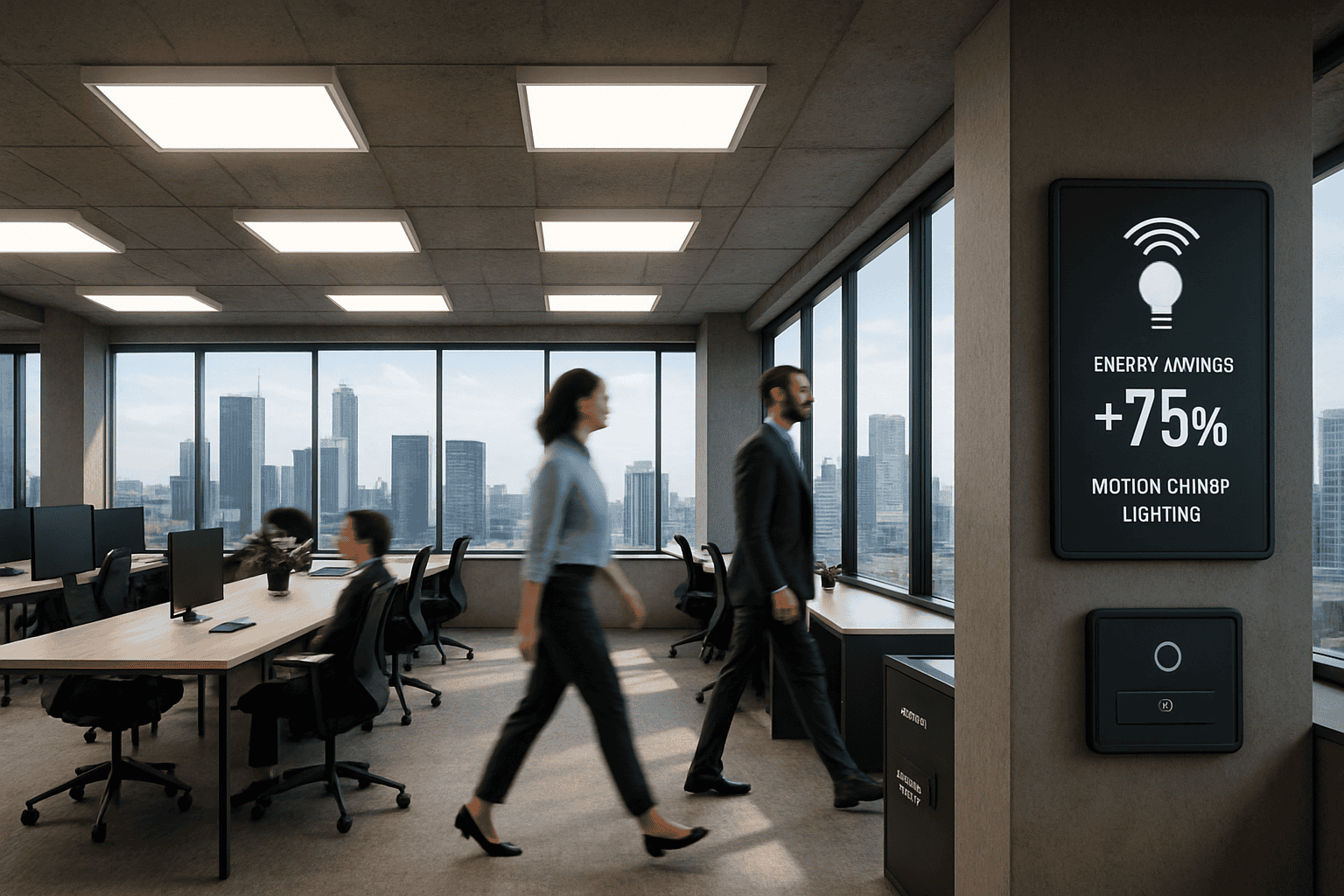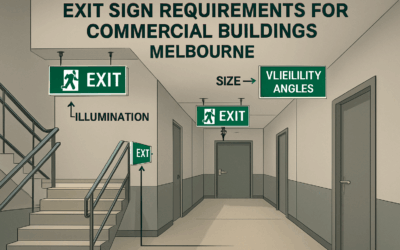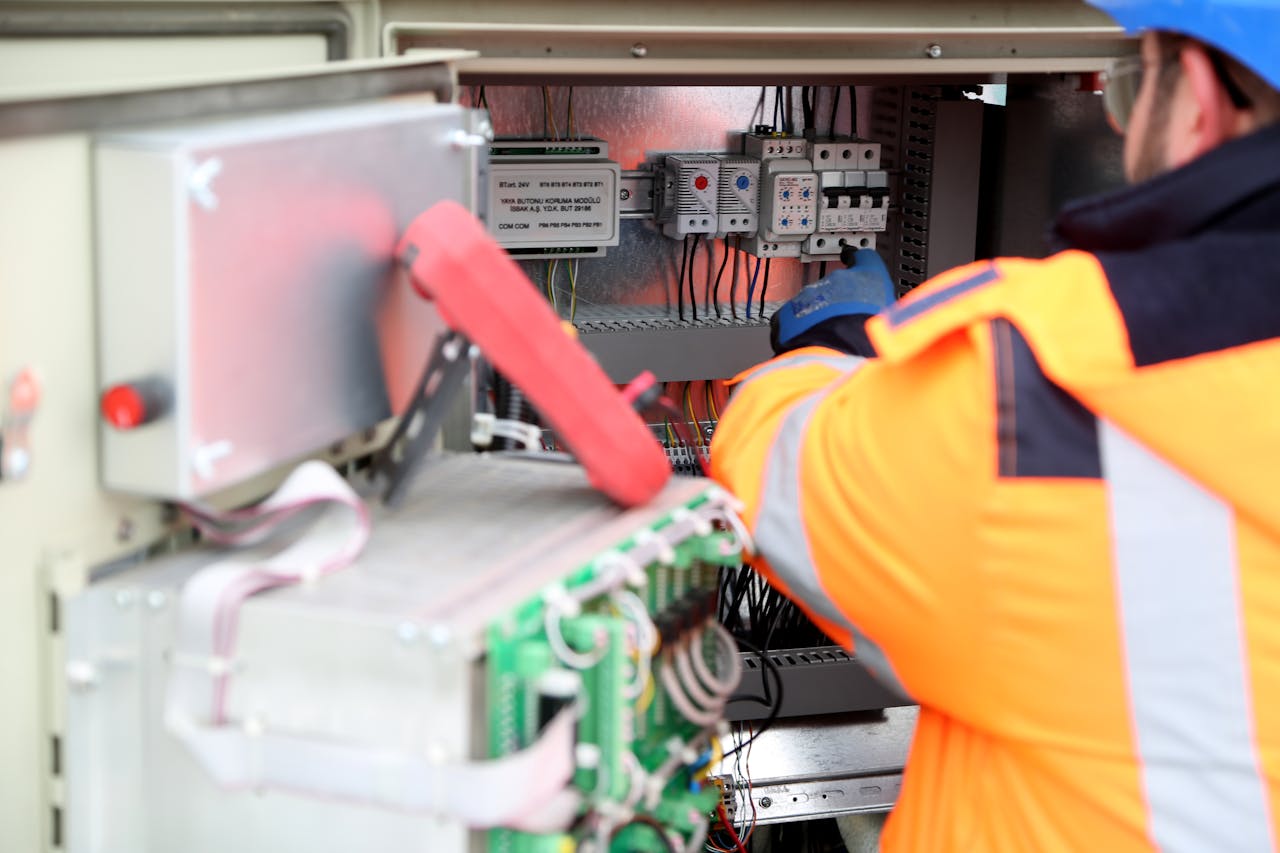- Why Motion Sensor Lighting Is Essential for Your Business
- How Motion Sensor Lighting Works and Its Key Features
- Local Melbourne Context: Best Practices, Codes, and Regulations
- Planning Your Motion Sensor Lighting Installation
- Features and Benefits of Motion Sensor Lighting Systems
- Practical Tips for Engaging the Best Commercial Electrician in Melbourne
- Steps to a Successful Motion Sensor Lighting Retrofit
- How Motion Sensor Technology Benefits Various Commercial Environments
- Future-Proofing Your Business with Smart Lighting
- Conclusion
Motion Sensor Lighting Systems for Melbourne Offices
Small business owners, listen up! If you’re looking to boost your workspace’s efficiency, security, and overall ambience in Melbourne, motion sensor lighting could be your new best friend. In today’s article, we’re diving deep into the world of motion sensor lighting, especially focusing on its application in commercial spaces such as offices, warehouses, and even retail spaces. If you’ve ever wondered how to cut down on energy costs while enhancing security and creating a smart working environment, then you’ve come to the right place.
This guide will walk you through:
- Why motion sensor lighting is a game changer for commercial properties in Melbourne.
- The special benefits and features of modern motion-sensor lighting systems.
- Practical tips on picking the right commercial electricians and installation experts.
- How to prepare your workspace for a seamless lighting upgrade.
- An overview of local best practices, codes, and regulations Melbourne business owners must follow.
Let’s get started and explore how motion sensor lighting for commercial properties in Melbourne can transform your office space!
Why Motion Sensor Lighting Is Essential for Your Business
Motion sensor lighting systems have evolved beyond just switching on and off. These smart lighting solutions now come with features that enhance energy efficiency, security, and overall operational efficiency.
Energy Efficient Lighting Solutions in Melbourne
Running a small business means keeping an eye on your overhead costs. Electricity bills can quickly add up, especially if your office lights are on 24/7. This is where energy efficient office lighting solutions come into play. Motion activated lighting for businesses ensures that lights are only on when needed, significantly reducing waste and lowering energy bills. For example, smart lighting systems in Melbourne offices can be integrated with occupancy sensors for office buildings, automatically dimming lights in unoccupied areas and switching them off completely after a period of inactivity.
Enhanced Security Through Automation
Office motion sensor lighting installation isn’t just about energy savings—it’s about safety, too. Imagine leaving your office after hours and knowing that your building remains secure. Motion detector lights for warehouses and commercial properties in Melbourne provide an extra layer of security by automatically turning on when movement is detected around the premises. This can help deter potential intruders and create a secure, well-lit environment both during and after business hours.
Sustainability and Cost Savings
With rising energy costs and increasing environmental concerns, sustainable lighting solutions for businesses have become not just a choice but a necessity. Energy saving lighting controls, such as LED motion sensor lights, offer a cost-effective solution for commercial lighting upgrades in Melbourne. They reduce electrical consumption while also lowering carbon footprints, which is an impressive win-win for any business owner focused on sustainable practices.
How Motion Sensor Lighting Works and Its Key Features
Before diving into adopting the technology, it’s essential to grasp how motion sensor lighting systems work. At the core, these systems rely on sensors—primarily Passive Infrared (PIR) sensors—that detect physical movement within their range. Once movement is detected, the sensor sends a signal to the lighting control system, triggering the lights to come on.
Features of Modern Motion Sensor Lights
- Automated Lighting Control: No more fumbling for light switches. These systems automatically manage lighting based on occupancy, making them perfect for offices where foot traffic can vary throughout the day.
- Adjustable Sensitivity: Tailor the sensor’s sensitivity depending on the space’s needs. Whether you need a system that responds immediately or one that benefits from a delay, features are adjustable.
- Integration with Daylight Harvesting Systems: Many systems now come with built-in daylight sensors, allowing for a hybrid approach. Outdoor daylight or natural light from windows can be used to dim the lighting system accordingly, optimizing energy efficiency.
- Remote-Controlled and Programmable Settings: Some advanced systems offer remote control via smartphone apps or central building automation systems, ensuring that business owners or facility managers can adjust settings even when off-site.
Benefits of Integrating Motion Sensor Lighting in Your Office
- Cost Savings on Electricity Bills: With lights only using power when needed, businesses can enjoy significant savings.
- Reduced Carbon Footprint: Energy efficient lighting solutions contribute to reduced greenhouse gas emissions.
- Enhanced Safety and Security: Automatic light systems for offices deter intruders and ensure well-lit spaces, which improves overall staff safety.
- Longevity of LED Lights: Modern LED motion sensor lights have a much longer operational life compared to traditional bulbs, meaning lower maintenance and replacement costs.
- Improved Employee Productivity: A well-lit work environment can boost morale and productivity. When employees aren’t bickering over poorly lit workstations, you get a happier, more efficient team.
Local Melbourne Context: Best Practices, Codes, and Regulations
When upgrading to motion sensor lighting systems in your Melbourne commercial property, it’s essential to keep local regulations and safety standards in mind.
Understanding Melbourne’s Commercial Lighting Codes
Melbourne’s building codes and commercial electrical requirements are specific and rigorous. Commercial electricians Melbourne specialists must be aware of:
- Electrical Safety Standards: All installations have to comply with Australian electrical safety standards. Licensed commercial electrical services in Melbourne ensure that your project meets these safety requirements.
- Energy Efficiency Regulations: Many local councils and the Australian government have initiatives to phase out inefficiencies in lighting systems. Integrating energy saving lighting controls not only saves you money but also contributes to complying with local energy efficiency mandates.
- Fire Safety Codes: Proper lighting is a crucial aspect of emergency and fire safety planning. Commercial lighting automation systems are now designed to remain operational even during power outages or emergencies, ensuring a continuous safe egress in emergency situations.
- Building Certification Requirements: If your building is undergoing renovation or a new office space is being constructed, ensure that installing occupancy-based lighting control systems meets the necessary building certification and compliance criteria. It’s a good idea to have this verified by a licensed commercial electrician who is well-versed in Melbourne’s building regulations.
Engaging the Right Commercial Electricians in Melbourne
Working with local professionals can make a world of difference. A qualified Melbourne commercial electrician brings a wealth of local knowledge and ensures that:
- The installation adheres to all local codes.
- Any retrofitting or upgrades are done efficiently.
- Your systems are future-proof and seamlessly integrated with building management systems.
- You receive ongoing maintenance advice and support for your smart lighting systems.
Planning Your Motion Sensor Lighting Installation
Before you jump into upgrading your commercial space with motion sensor lighting, a bit of planning can save you time and money in the long run. Here’s a step-by-step guide on preparing for the job.
1. Assess Your Office Layout and Requirements
Start by evaluating your current lighting setup. Identify areas that:
- Remain unoccupied for extended periods.
- Require additional security lighting, such as hallways, parking lots, or entry points.
- Could benefit from energy efficient lighting like LED motion sensor lights.
A detailed audit of your space can help you determine the number of motion sensor installations needed, the best locations for sensor placement, and whether additional features like daylight harvesting are necessary.
2. Determine the Best Lighting Solutions for Your Needs
Once you’ve assessed your needs, research different types of motion sensor lighting. Consider:
- LED Motion Sensor Lights: They’re energy efficient, long-lasting, and well-suited for commercial environments.
- Occupancy Sensors for Office Buildings: These sensors are excellent for areas with fluctuating occupancy, ensuring lights only remain on when needed.
- PIR Sensor Lighting Commercial Options: These are commonly used in Melbourne for their reliability and ease of integration with existing systems.
3. Consult with a Local Commercial Lighting Contractor
Local specialists will provide tailored advice to fit Melbourne’s unique building structures and regulatory requirements. Whether you’re upgrading under existing conditions or working on a new project, engaging a commercial electrician Melbourne expert can help you:
- Design the most efficient layout.
- Choose systems that offer both energy savings and security enhancements.
- Ensure the installation process is smooth and complies with local regulations.
4. Create a Detailed Installation Plan
An effective installation plan should include the following:
- A map of your premises with designated sensor locations.
- A timeline for installation and testing.
- A contingency plan in case of unexpected delays.
- Coordination details if the installation involves working after business hours to minimize disruption.
5. Budget and ROI Analysis
While the upfront cost of installing smart lighting systems might be higher than traditional systems, the long-term savings can be substantial. Consider:
- Reduced energy consumption.
- Longer lifespan of LED lights.
- Reduced maintenance costs.
- Any potential rebates or incentives from local councils aimed at energy-efficient upgrades.
This cost analysis will not only justify the investment but also help communicate the benefits to stakeholders within your organisation.
Features and Benefits of Motion Sensor Lighting Systems
Let’s break down the key features and benefits that make motion sensor lighting ideal for Melbourne offices and commercial spaces.
Key Features
- Automatic Activation: With sensor-based lighting controls, lights come on instantly when movement is detected and automatically switch off if no activity is noted within a set timeframe.
- Customisable Settings: Choose from various sensitivity and delay settings. Whether you have a busy office or a quiet storage area, the settings can be adjusted to meet specific requirements.
- Scalability: Modern systems can be easily expanded. Whether you’re doing a small office or a large commercial complex, your lighting solution can grow as your business expands.
- Integration with Smart Systems: Advanced lighting solutions offer compatibility with other smart building systems, including HVAC and security systems, providing a holistic approach to building automation.
- Remote Monitoring and Control: Some installations offer remote upgrade capabilities, allowing you to monitor energy usage and control lighting via a web-based interface or mobile app.
Direct Benefits to Your Business
- Lower Operating Costs: Automatic light systems for offices reduce wasteful energy use, leading to significantly lower electricity bills.
- Enhanced Employee Productivity: A well-designed, energy-efficient environment contributes to comfort and productivity. Proper lighting has even been linked to reduced eye strain and improved mood.
- Increased Security and Safety: With commercial lighting automation in place, new security and safety measures ensure that dark, unoccupied areas are instantly illuminated, providing peace of mind.
- Reduced Carbon Footprint: Moving towards sustainable lighting solutions not only saves money but also reduces your business’s environmental impact—a strong selling point in today’s eco-conscious market.
- Adaptability to Future Technologies: By installing sensor-based systems now, you future-proof your property. As technology advances, these systems can be updated or integrated with new smart office lighting solutions in Melbourne.
Practical Tips for Engaging the Best Commercial Electrician in Melbourne
Now that you’re sold on the idea of motion sensor lighting, here are some practical tips to guide you in finding and collaborating with the ideal commercial electrician for your project.
Finding the Right Expert
- Check Their Accreditation and Licensing: When searching for commercial electrical contractors in Melbourne, make sure they are fully licensed and have a proven track record in handling commercial properties.
- Look for Local Experience: Local experts will be more familiar with Melbourne’s building codes, regulations, and environmental conditions which can directly impact the installation of motion sensor lighting systems.
- Request Case Studies or Testimonials: Ask for previous project examples, specifically in office motion sensor lighting installation or other commercial lighting automation projects. This will give you confidence in their ability to deliver quality work.
- Compare Quotes and Services: Get multiple quotes and assess what services are included—such as post-installation support, routine maintenance, and warranties on the equipment.
- Verify Insurance and Guarantees: Ensure that the contractor’s work is covered by insurance and that they offer some form of workmanship guarantee. This adds an extra layer of security and trust to your project.
Preparing for the Lighting Upgrade
- Conduct an Energy Audit: Before installation, understand your current energy usage. This audit, which can often be performed by your commercial electrician, will help optimize lighting placements and settings.
- Plan for Minimal Disruption: Schedule installations during off-peak hours or weekends to avoid affecting your business operations. A clear plan prevents unexpected downtime.
- Communicate with Your Team: Inform your staff about the upcoming changes. This helps manage expectations and ensures that everyone is aware of any temporary disruptions during the installation process.
- Test the System Thoroughly: Once installed, ensure that the sensors and lighting systems are tested thoroughly in different scenarios. This minimizes the risk of malfunctions and ensures that the system meets your operational needs.
Steps to a Successful Motion Sensor Lighting Retrofit
If your office is already up and running, a retrofit to install motion sensor lighting may be on your radar. Here’s how to do it effectively:
Step 1: Detailed Assessment
- Site Survey: Conduct a comprehensive survey of your premises to identify the optimal locations for sensor installation. Areas like entryways, restrooms, meeting rooms, and corridors are common targets.
- Lighting Audit: Review your existing lighting layout. Determine which areas have high energy consumption and which could benefit most from automation. Using energy management lighting systems can help map usage patterns.
Step 2: Choose the Right Technology
- LED Retrofit Options: Upgrading existing fixtures to LED motion sensor lights is one of the most cost-effective options. This not only improves energy efficiency but also ensures longevity.
- Sensor Sensitivity and Range: Ensure that the chosen sensors offer appropriate sensitivity for your workspace. Overly sensitive sensors may lead to unnecessary activations, while under-sensitive ones might fail to detect movement.
- Integration Potential: Consider systems that can eventually integrate with other building automation features such as HVAC systems or security monitoring systems. Smart office lighting Melbourne options often provide this adaptability.
Step 3: Installation and Testing
- Professional Installation: Hire a reputable commercial electrician in Melbourne who is already experienced with sensor-based lighting controls. Their local expertise means they will be familiar with Melbourne’s compliance requirements.
- Phase-wise Implementation: For larger offices, consider implementing the system in phases. This minimizes disruption and allows time to assess effectiveness before wide-scale adoption.
- Post-installation Testing: Once installed, the system should be thoroughly tested under various conditions (daylight, nighttime, heavy occupancy, etc.) to ensure it performs reliably in all scenarios.
Step 4: Maintenance and Upkeep
- Regular Inspections: Schedule regular maintenance checks with your commercial electrical contractor. Routine inspections can prevent future issues and ensure that sensors remain calibrated.
- System Updates: Stay informed on technological advances. Software updates for smart lighting systems can often bring new features and improved energy-saving functionalities.
- Document Performance Metrics: Keep records of energy consumption before and after installation. These metrics help justify the ROI and may also aid in applying for any government rebates or local incentives.
How Motion Sensor Technology Benefits Various Commercial Environments
While our primary focus is on Melbourne office spaces, motion sensor lighting has a broad range of applications that cater to different commercial environments.
For Retail Spaces
- Enhanced Shopping Experience: Sensor lights can ensure that entryways and aisles are comfortably lit only when customers are present, creating a pleasant in-store experience.
- Cost-effective Energy Use: With lower electricity consumption during off-peak times, retail spaces enjoy reduced operating costs.
For Warehouses and Industrial Facilities
- Improved Safety: Motion activated lighting for businesses is crucial in dense storage areas where obstructions may cause accidents. PIR sensor lighting commercial options can provide instant illumination when movement is detected.
- Operational Efficiency: Automated light systems for offices and industrial spaces ensure that energy is only spent when and where it is needed, streamlining operations and reducing overhead expenses.
For Corporate Offices
- Smart Work Environments: Occupancy sensors for office buildings foster an innovative, technology-driven workplace. Employees benefit from responsive lighting that adjusts to natural changes throughout the day.
- Security Enhancements: With motion sensor lighting integrated into overall security systems, surveillance and emergency lighting protocols become more robust, contributing to a safer corporate environment.
Future-Proofing Your Business with Smart Lighting
As businesses in Melbourne continue to embrace technology, integrating smart lighting systems into your office becomes an investment in the future. Here’s how motion sensor lighting upgrades can play a pivotal role:
Adaptability and Scalability
Smart lighting systems are designed to be flexible. They can scale with your business, allowing for gradual expansion as your needs grow. Whether you’re planning major office renovations or gradually retrofitting your existing build, sensor-based lighting control systems offer the adaptability that modern businesses require.
Integration with Building Automation
Increasingly, Melbourne’s commercial buildings are incorporating smart building technologies. By installing automated lighting control systems now, you lay the foundation for further integrations such as HVAC management, security systems, and energy monitoring solutions. This synergy not only optimizes energy use but also creates a cohesive, technologically advanced workspace.
Sustainability as a Business Imperative
Sustainability isn’t a trend—it’s an expectation. Adopting cutting-edge, energy efficient lighting solutions like LED motion sensor lights positions your business as environmentally responsible. With many local councils and governmental organizations offering incentives for sustainable practices, your investment in smart lighting is likely to reap both environmental and financial rewards.
Real-Time Data and Analytics
Modern systems often include data analytics capabilities. These tools offer insights into lighting usage patterns, helping you identify further opportunities for energy savings. Over time, real-time monitoring of your energy efficiency can guide future decisions and optimizations.
Conclusion
Motion sensor lighting systems are more than just a modern convenience—they’re a vital part of creating efficient, secure, and cost-effective commercial spaces in Melbourne. With energy efficient office lighting solutions saving money, enhanced security features ensuring safety, and smart building automation integrating seamlessly with existing systems, upgrading to motion sensor lighting is a smart move for any business owner.
By:
• Understanding Melbourne’s regulatory landscape and electrical codes,
• Choosing local, qualified commercial electricians for installation, and
• Preparing your workspace with a detailed plan and ongoing maintenance schedule,
you set the stage for a future-proof, adaptable lighting solution that meets the evolving demands of your business.
For businesses searching for terms like “motion sensor lighting for commercial properties Melbourne,” “office motion sensor lighting installation,” or “commercial lighting upgrades Melbourne,” the answer is clear. Embrace these energy saving, sustainable lighting controls and enjoy the benefits of a smarter, safer, and more efficient office environment.
Contact your local commercial electricians in Melbourne today to discuss how motion sensor lighting can revolutionise your workspace—combining smart technology with cost-effectiveness and a green approach. The perfect blend of innovation and practicality is just one phone call away!
Remember, smart decisions in commercial lighting not only boost your bottom line but also set you apart as a forward-thinking, environmentally responsible business. With motion sensor lighting technology at the forefront, your Melbourne office can shine bright—without wasting energy or compromising on safety. Whether it’s upgrading your current system, retrofitting older fixtures with LED motion sensor lights, or starting a smart office lighting solution from scratch, the future is illuminated.
Now’s the time to take that step towards a smarter, more sustainable office environment. Happy lighting and here’s to a brighter, energy-efficient future for your business in Melbourne!





0 Comments